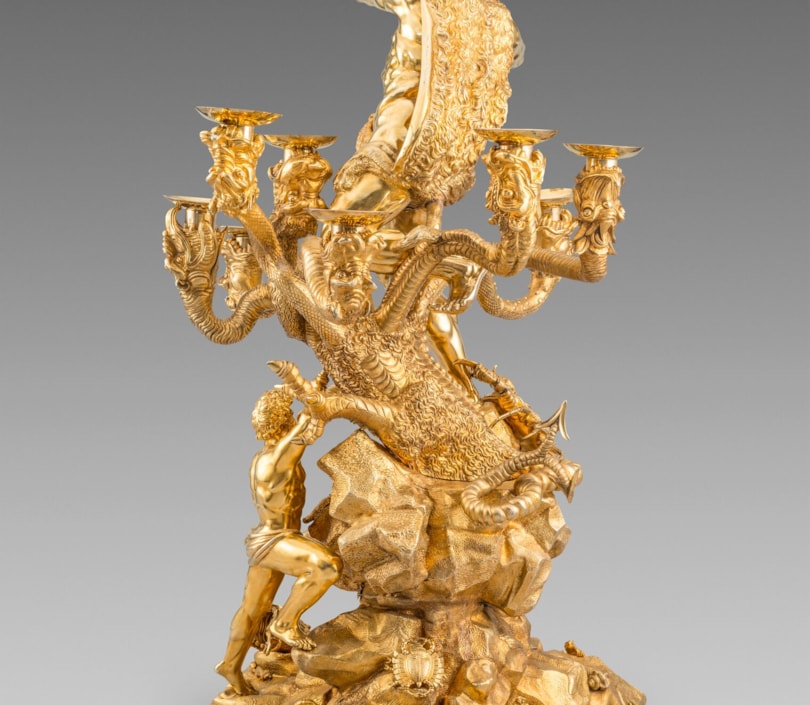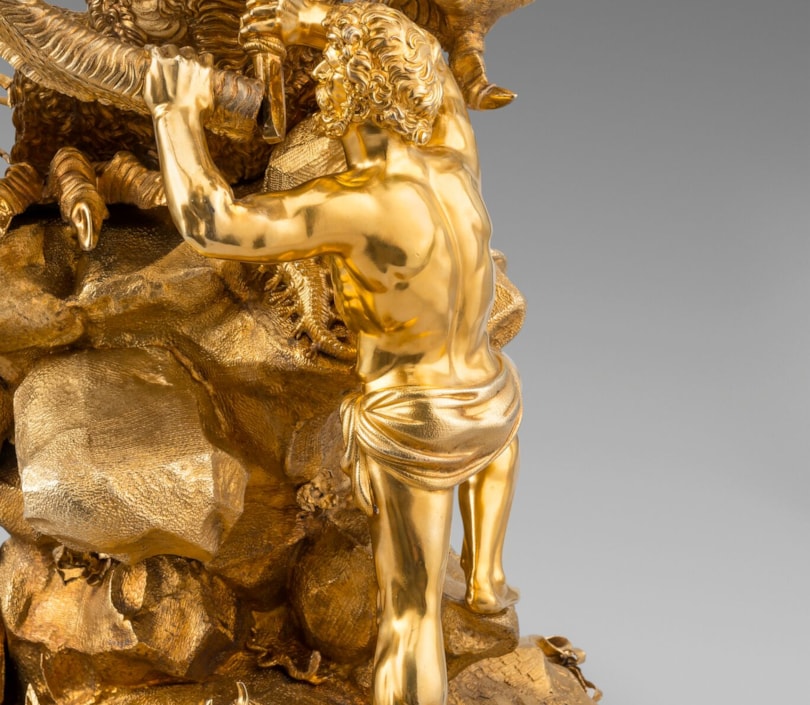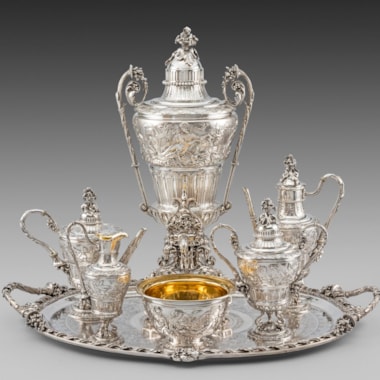Modelled as the second labour of Hercules in which he slays the Lernean Hydra, the base cast and chased as a rock outcrop which supports the Hydra, the base applied with foliage and creatures among which rests one of the severed heads of the Hydra and further supporting a cast figure of Iolaus who is holding a dagger to one of the necks of the Hydra, all surmounted by Hercules, draped in a lion's pelt and loin cloth, wielding a club, the monster's nine heads arranged asymmetrically and forming the candle sockets, each with a plain nozzle, a large crab clings to Hercules's right ankle, marked on Hercules' pelt, loin cloth, club, nozzles, Hydra, crab, Iolaus, base and many of the detachable elements on the base.
The Duke of York's Silver Supplied by Kensington Lewis
The extraordinary group of silver made for the Duke of York under the direction of the retailer and antiquarian, Kensington Lewis, was the most innovative silver of its time, anticipating the full-blown historicism of the mid-19th century. The Duke of York and his elder brother, the Prince Regent (after 1820, King George IV), were together the most influential collectors and patrons of silver in the first quarter of the century. The Duke of York's silver, however, was based largely on baroque sources, and stands apart from the classical styles promoted by the Royal Goldsmiths, Rundell Bridge and Rundell and supplied to the King.
Credit for the distinctive style of the Duke of York's silver must be given to Kensington Lewis, whose passion for 17th-century silver was demonstrated by his purchases in the Duke of Norfolk's auction in 1816. There, he acquired a salver decorated with "figures of marine deities" or "sea nymphs and tritons in relief," and a tankard with "a feast of the Gods, in exquisite bas-relief . . . Alexander visiting the tent of Darius . . . the handle formed as a syren." Lewis was retailer of the twelve remarkable Aldobrandini Tazze, which he exhibited in 1826. Such objects in Lewis's possession undoubtedly influenced his designs for new silver objects, executed for him by Edward Farrell (see lots 198-200). John Culme proposed this thesis in his important study, "Kensington Lewis: A Nineteenth Century Businessman" (Connoisseur, September 1975, London, Vol. 100, no. 763 pp. 26-41).
A broader review of the antiquarian influences on Royal plate was made in an article by Shirley Bury, Alexandra Wedgwood and Michael Snodin in The Burlington Magazine (“The Antiquarian Plate of George IV: A Gloss on E. A. Jones”, June 1979, vol. 121, no. 915, pp. 343-351, 353). The authors reason that the inventiveness met the need for “embellishment” of Royal interiors such as Windsor Castle, rather than solely providing extensive dining services (op. cit., p. 349).
Lewis, an expert salesman, was able to channel the Duke of York's profligate spending toward Farrell, a talented silversmith capable of creating new designs from a variety of historical sources. It was this phenomenal collaboration of patron, retailer, and craftsman which resulted in these extravagant and highly original objects. Four pieces from the Duke of York's commissions, including Lewis and Farrell's masterpiece, the Hercules candelabrum (lot 200), were sold, the C. Ruxton and Audrey B. Love Collection; Christie's, New York, 19 October 2004.
The Prince Frederick, Duke of York and Albany (1763-1827)
The Duke of York was born Prince Fredrick Augustus, second son of King George III. In 1780, at the age of seventeen, he was made Colonel in the Royal Army, beginning his lifelong military career. In 1794, he was created Duke of York and Albany. At the age of 28, he dutifully married Princess Frederica, eldest daughter of Friedrich Wilhelm II, King of Prussia, although they separated fairly shortly thereafter. At the time of his marriage in 1791 he was said to have had the enormous annual income of £70,000.
Following the outbreak of the war with France in 1793, the Duke fought in the Flanders campaigns and became Commander-in-Chief of the Army five years later. In 1809 he was accused of corruption on account of the practices of his mistress, Mary Ann Clark, who profited from her intimacy with the Commander-in-Chief by selling promotions to officers. The scandal forced him to resign for two years, but he was reinstated in 1811.
The 1827 Duke of York Sale at Christie’s
When the Duke of York died in 1827, his debts totalled somewhere between £200,000 and £500,000 – the imprecise figure being perhaps an indication of just how chaotic the Duke's financial affairs were at the time of his death. In order to try to satisfy these huge debts, his executors took the unprecedented step of selling a Royal collection at public auction. The Duke of York's silver was offered at Christie's in a four-day sale starting on 19 March 1827. Viewing of the silver was by ticket, and a copy of the catalogue admitted the prospective buyer to the auction itself. At the outset of the sale, James Christie II eulogized the late Duke and was "warmly applauded by the company." No doubt his announcement that the sale "had not a single reserve" was equally well received. The total for the four-day sale of silver was £22,439/10s while the Duke's arms and armour collection and furniture brought in a further £15,000 or so.
The 1827 Duke of York sale included a number of other items described as being "by Lewis," the most significant being the Hercules candelabrum centrepiece (lot 200). In addition, there are several more lots of silver that, from their descriptions alone, can confidently be attributed to Farrell and were therefore presumably supplied by Lewis. In his 1975 article on Kensington Lewis in Connoissuer, John Culme identifies three items that were commissioned by Lewis for the Duke of York: the Hercules centrepiece, a massive pair of ewers with the arms of France, and a large pair of salvers. Since that date, seven lots of silver made by Farrell for the Duke of York have come to light (A. Phillips and J. Sloane, Antiquity Revisited, 1996, p. 67, footnote 10). The Love Collection contributed three more pieces to this group: a pair of large six-light Neptune candelabra, a smaller pair of four-light candelabra with Triton and Nereid stems, a the ewer decorated by Farrell, all of which can be identified in the 1827 sale.
Unfortunately for Lewis, the death of the Duke of York seems to have led to a rapid decline in his business. Not only did he lose his most important client, but the Duke had owed him £2,300, a debt that took the estate eighteen years to repay. In addition, the bad publicity surrounding the prices fetched at the Duke of York's estate auction – in many cases a quarter or less than those originally charged by Lewis – can hardly have helped his reputation. After a series of bad real estate investments and a short time in debtor's prison, he died in 1854.
The Duke of York's Hercules Centrepiece
One of the most important pieces of silver from the first half of the 19th century, the Duke of York's Hercules centrepiece can justifiably be claimed to be Kensington Lewis and Edward Farrell's masterpiece. Based on both renaissance and baroque design sources, it is the ultimate example of historic eclecticism in English silver design.
Given that the Duke of York was best known as Commander-in-Chief of the Army, it is likely that Hercules was chosen as the subject of this centrepiece to symbolise that important office. The image of Hercules Slaying the Hydra has been used for centuries to imply military might as well as victory over vices, and the Hydra can be seen as representing the enemies of England. English artist John Flaxman had used Hercules and the Hydra as the central relief on his silver "Trafalgar Vase" of 1805, inscribed "Britannia Triumphant Britons Strike Home."
The choice of subject may have been influenced by allegory, but Hercules Slaying the Hydra was an influential subject for silversmiths from the 16th and 17th centuries. The subject was popularised by renowned sculptor Adriaen de Vries (1556-1626) in his design for one of two fountains for the city of Augsburg. Craftsmen and goldsmiths from courts across Europe were dispatched to Augsburg to see his masterpieces. Prints after de Vries’s works were later published by Jan Muller. A figure by silversmith Philipp Kusel, Augsburg, c. 1690 sold, From Roentgen to Faberge: A European Private Collection; Christie’s, London, 20 May 2015, lot 25. Another by Albecht Biller, Augsburg, 1700, is in the Maximilianmuseum, Augsburg.
Lewis and Farrell included the traditional attributes of Hercules in this sculptural group, such as the crab sent by Hera to aid the Hydra and Hercules's ally Iolaus, the actual composition of the model seems to be their own invention, a combination of various design sources. It was first argued that Hercules's pose derives ultimately from Michelangelo's figure of Charon in the Sistine Chapel, which influenced a depiction of Hercules by Ciro Ferri, popularized by engravings in the 17th century. Professor David Ekserdjian has recently suggested that Hercules’s stance was influenced by an engraving of Guido Reni’s painting of Hercules Slaying the Hydra (1617-20, Musée du Louvre, Paris). The figure of Iolaus is modelled after Verrochio's figure of the Executioner in a silver plaque of the Beheading of St. John the Baptist, found on an altar made for the Duomo in Florence around 1480. It is the combination of the two figures, from two different centuries and lifted entirely out of their original contexts, which is so typical of Lewis's highly eclectic style, interpreted by Farrell.
The Hercules centrepiece took pride of place on the title page of the Duke of York auction catalogue, appearing with "the grand work of art, THE SHIELD OF ACHILLES" and described as:
A GRAND CANDELABRUM
COMPOSED OF A GROUP OF HERCULES DESTROYING THE HYDRA
Of Silver Gilt, weighing upwards of One Thousand ounces, made by Mr. Lewis
Inside the catalogue, it was described as lot 62 in the first day's sale:
MASSIVE SILVER GILT PLATE [. . .]
A MAGNIFICENT CANDELABRUM, or group, for the centre of table, (made by Lewis) representing HERCULES ATTACKING the HYDRA, and surrounded by its nine heads, which bear as many nozzles for lights. Iolaus, the companion of Hercules, is searing a neck of the monster below. The group is supported on a mass of rock work, about the base of which are various reptiles.
Weight of the whole, 1144 oz. 5dwts.
THIS VERY GRAND and MASSIVE PIECE of PLATE, rests upon a base of brass, forming the lower part of the rock, and is supported upon brass castors, to facilitate the placing it in the centre of the table. Also, a very strong mahogany chest or cabinet, brass bound, to contain the candelabrum.
The prices for the auction as a whole, and the centrepiece in particular, were not good. According to one newspaper, "the general opinion was, that the articles did not bring near so much as they were worth intrinsically, and certainly not as much as they cost, especially the splendid massive silver plate." The centrepiece was knocked down for £343/5/6, or 6s an ounce - something in the region of a quarter of its original purchase price. Indeed, the newspaper reported that "after Mr. Christie had dwelt a considerable time at the bidding, there was a murmur ran round the room of 'How cheap!' when the hammer fell. Mr. Christie said that the candelabrum was purchased by the late illustrious owner of the new Palace, which it pleased Providence that he was never to inhabit. 'Notwithstanding I feel sorry for the sacrifice which has been made in this article,' said Mr. Christie, 'I feel greater grief that the workmanship of the artist is valued so low. The design is most beautiful, and there exists only another like it in England.'” If indeed there was another like it, it is entirely unknown today.
H.R.H. Prince Frederick Augustus, Duke of York and Albany, K.G., P.C., G.C.B. (1763 - 1827), second son
of George III.
The Magnificent Silver and Silver-Gilt Plate of His Royal Highness, The Duke of York, Deceased; Christie's, London, 19-22 March 1827, lot 62.
Sir Clive Milnes-Coates, 2nd Bt. (1879-1972) of Helperby Hall, Yorkshire.
Sir Clive Milnes-Coates, 2nd Bt. (in whose family the centrepiece had been since the Duke of York's sale); Christie's London, 18 October 1967, lot 59.
The C. Ruxton and Audrey B. Love Collection, Magnificent Silver-Gilt including Russian Works of Art and Objects of Vertu; Christie's, New York, 19 October 2004, lot 200.
Christie's Review of the Season, 1967 - 1968, London, 1968, pp. 150-151.
A. Grimwade, "Two Great Royal Silver Sales," Christie's Review of the Season, London, 1975, pp. 196-197.
J. Culme, "Kensington Lewis: a Nineteenth-Century Businessman," Connoisseur, September 1975, pp. 31 and 36.
J. Culme, Nineteenth-Century Silver, London, 1977, pp. 73-74.
M. Clayton, Christie's Pictorial History of English and American Silver, Oxford, 1985, fig. 7, p. 249.
A. Phillips and J. Sloane, Exhibition catalogue, Antiquity Revisited: English and French Silver-Gilt, London, 1997, p. 62, no. 12.
F. Russell and N. White, Exhibition Catalogue, Defining British Art, London, Christie's, 2016, p. 125-128.
Going Once: 250 Years of Culture, Taste and Collecting at Christie's, 'Hercules and The Duke', London, 2016, p. 260, no. 137.
You May Also Like














































































